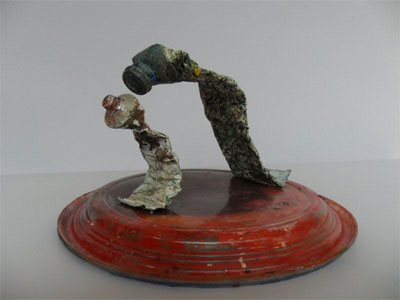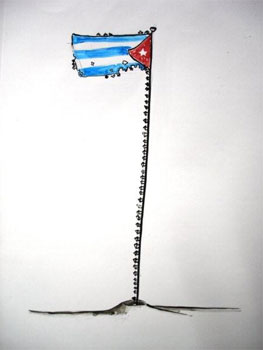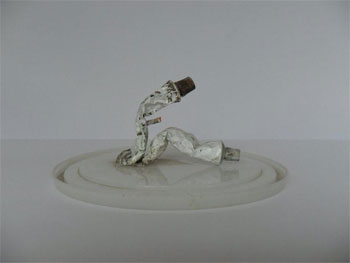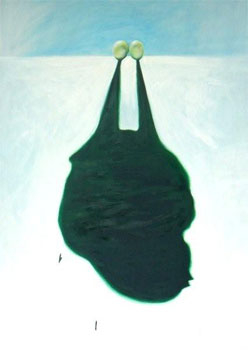A Young Innovator of Current Cuban Art
Helson Hernandez
 HAVANA TIMES — Maykel Sotomayor is a young creator of visual arts who is defining the path of this work on the island today. He’s motivated by what’s called object-oriented and landscape art; after he first dabbled in graphical humor. Maykel agreed to talk about his work and concerns with Havana Times.
HAVANA TIMES — Maykel Sotomayor is a young creator of visual arts who is defining the path of this work on the island today. He’s motivated by what’s called object-oriented and landscape art; after he first dabbled in graphical humor. Maykel agreed to talk about his work and concerns with Havana Times.
HT: What can you tell us about how you got into art?
Maykel Sotomayor: I’ve always been interested in creating with sincerity. I think the opportunity of having one’s work shown is very encouraging for an artist. Likewise, exchanges with the viewers are very useful. Knowing what they think sometimes serves for the creation of other pieces.
I was fortunate to be able to publish and be part of the Ubre del humor, a humor newspaper that’s a supplement to La Calle del medio. Later I received the award in the category of general humor at the Third National Youth Humor Assembly in San Antonio de los Baños, and I’m currently a member of the Asociacion Hermanos Saiz cultural youth organization. If there’s something important and gives a sense of progress to a young artist, it’s having their work seen or heard.
HT: What academic study contributed to the current artistic scope of your work?
MS: Graduating from San Alejandro played a major role in terms of the artistic maturity I was able to acquire. It gave direction to the ideas I was following. But it was not until the third year of study that I felt that vibration one gets when you identify yourself at a deeper level …when you know that this is going to be with you for a long time or even for a whole life. That was in 2007 when I was with a painting workshop led by the professor and visual artist Rocio Garcia, who spoke publicly about an updated painting style that focused mainly on the study of Fauve’s approach.
 That was a style that developed in the early twentieth century, when work was done with areas and the intensities of colors, among other things; it became a school for me. The professors who specialized in this were coming fresh out of ISA (the Superior Institute of Art) and were quite generous about their knowledge, which helped us students form contemporary concepts and kept alive our interests and desires to produce art that went beyond aesthetic conformity. This has come to serve as the basis of my current work.
That was a style that developed in the early twentieth century, when work was done with areas and the intensities of colors, among other things; it became a school for me. The professors who specialized in this were coming fresh out of ISA (the Superior Institute of Art) and were quite generous about their knowledge, which helped us students form contemporary concepts and kept alive our interests and desires to produce art that went beyond aesthetic conformity. This has come to serve as the basis of my current work.
HT: In your painting work, we can perceive certain characteristics that distinguish you.
MS: I think it’s difficult for someone to distinguish themself in painting today. I think there can be differences about what an artist is able to say about what they do.
The technical tools of a painter come packed with a lot of precedents, and this can be interesting and enriching according to what it is you’re looking at. But there’s also a rich tautology within familiar forms of painting. What I have tried to do is to make painting serve as the voice for what’s inside me, and my worries and concerns revolve around that. I’m not trying to give an impression of novelty in what I’m doing; rather, I’m trying to get people to reflect. I think that in perhaps in this way I can make a difference.
HT: Landscapes have become a theme in your paintings?
MS: I’m moved by the human being’s existential questions, ones that are so valid in contemporary society – just like questions of suspicion and doubt. These are what are conveyed in my work through landscapes, which are primarily gestural and expressionist. Landscape interests me at the time or the place when they have some vibrant comment to make. When I focus on or think about them, I do it in a way that’s quite focused on what I select, which usually comes with those elements. I only paint what is indispensable for promoting discourse.
 I feel a resonance in nature and a murmur that makes me look to see it. It’s like I’m a witness of facts and events. I’m seduced by the calm that can be seen in the countryside and the manner in which this can be inverted when I deal with it. I consider myself an interpreter of what is happening in the landscape, at least in my way of looking at things. Everything I do is about trying to share this.
I feel a resonance in nature and a murmur that makes me look to see it. It’s like I’m a witness of facts and events. I’m seduced by the calm that can be seen in the countryside and the manner in which this can be inverted when I deal with it. I consider myself an interpreter of what is happening in the landscape, at least in my way of looking at things. Everything I do is about trying to share this.
HT: Do you consider yourself part of that group of young people whose creative ideas flow in relation to their concerns about society?
MS: For me, the hard part is to separate myself from society. I’d go so far as to say that this is my muse, since it’s the sublime and the beautiful that lead one to the realization of a work, as do the contradictory differences between people. To date, most of my pieces have been inspired by that.
HT: Talk about the influence of graphic humor in your creative work.
MS: After graduating from San Alejandro and then doing my military service, I felt the need to communicate in an immediate manner. What this means is that I felt a greater commitment to my ideas and concerns, which grew increasingly and therefore required a rather fast medium. This medium is endowed with those qualities.
 Graphic humor has been were very useful to me when it came time to formulate my voice; I’m talking about things like irony and double meanings. These characteristics have been dealt with a lot, not only in graphic humor but also in the visual arts in general. I’ve almost always looked at this as a social critique. To be honest, I still wake up wanting to draw a cartoon.
Graphic humor has been were very useful to me when it came time to formulate my voice; I’m talking about things like irony and double meanings. These characteristics have been dealt with a lot, not only in graphic humor but also in the visual arts in general. I’ve almost always looked at this as a social critique. To be honest, I still wake up wanting to draw a cartoon.
HT: What about “Casita with a ‘C’ Like in Coconut”?
MS: This project started out as an exercise in will power. I wanted to do work that spoke of my concerns with landscape. But in this case it was more practical and spontaneous. Thus began a series where the materials used were small cut-up pieces of silver-covered cardboard with an acrylic wash. These were drawings. I remember it took only a few days to produce more than ten, and just because they were easy to make didn’t mean they lacked form or content – just the opposite.
This series became the source of my ideas. With it I saw myself defined by a process that previously cost me a little more work. After accumulating a few, I decided to organize a personal exhibition. I wanted one that spoke to the power of landscape as linked to the tremendous force that an idea can have through a naive drawing, one that’s almost like a child’s. It was placing a great weight on something very light; like the content that’s seen from a child’s drawing, which can be explosive.
I’ve always been struck by things that surprise, ones that tell you something without you having expected it.
 HT: How do you see your future in the visual arts on the island?
HT: How do you see your future in the visual arts on the island?
MS: I’m completing a painting that’s very important to me, one for which I still don’t have a space, but which I want to be in tune with the sacrifices I’ve made in creating it. Right now I really want to organize collective exhibits where one can feel the power of young painting, stripped of prejudice and having substance in its voice. What else I can say, I’m starting now, I still have a long way to go and I have a great deal of desire to continue creating.
HT: What is art object in the work of Maykel?
MS: Basically these pieces come from the recycling of painting materials, things that aren’t used any more …paint tubes or palettes, for instance. As I paint, I keep all those objects that contribute to the realization of a painting but then disappear.
I’m interested in the use of materials that have been thrown away in the process of painting, to construct scenes that attempt to collect a human appearance from empty paint tubes or not so empty palettes.
All of this is translated from object-based expressionism according to the purpose of the visuality embodied in whatever has been de-personified. This work is no more than an extension of the principles I’ve been employing in painting, especially in my earlier works.
